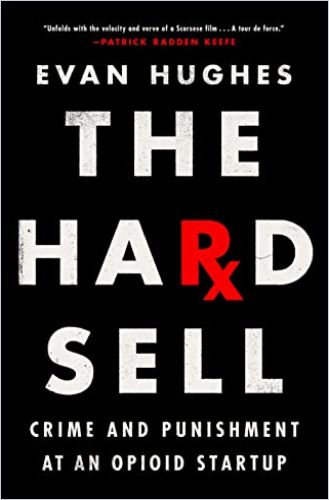Journalist and author Evan Hughes investigates in lively detail the rise and fall of fentanyl profiteer John Kapoor.

Addictions for Profit
Evan Hughes, who writes for The New York Review of Books and The New York Times Magazine, details how, at the peak of the US opioid epidemic, a profit-mad start-up founder ignored ethics and the law, making millions with a company that bribed doctors to overprescribe the lethal painkiller fentanyl. Insys’ founder John Kapoor became one of the richest men in America, says Hughes, through repeated involvement with controversial pharmaceutical companies. Hughes describes the aggressive sales tactics Kapoor embraced before facing prosecution, revealing a pervasive culture of corruption within the pharmaceutical industry.
Opioid Epidemic
John Kapoor founded a multimillion-dollar start-up by embracing illegal activities to fuel and profit from America’s addiction to opioids. The Indian-born founder of Insys Therapeutics created the painkiller Subsys, the active ingredient of which was fentanyl, a drug 100 times the strength of morphine. In 2013, the Arizona-based Insys Therapeutics became the best performing IPO (Initial Public Offering) of the year with a valuation gain of 400%. Its profits sprang from fraud, bribery and increasing patient opioid doses to addictive levels.
While a flood of prescription opioids has driven a national health crisis, the drug companies responsible, showered in riches, have been able to operate largely in secrecy, paying to settle cases that might otherwise crack open their ways of doing business.Evan Hughes
In 2019, Insys became the first opioid pharmaceutical company to face federal prosecution, though Hughes insists that Insys’ behavior aligns with the pharmaceutical industry norm.
Profit
In the 1980s, Kapoor invested $50,000 dollars in Lypho-Med, a generic-drug company, and took over as owner. The company – rebranded as Lyphomed – attracted controversy for its monopolized access to an antibiotic AIDS patients relied on as a pneumonia treatment.
Kapoor was a relentless boss but at heart a scientist, a tinkerer delighted by innovation.Evan Hughes
Kapoor sold the company to the Japanese-owned firm Fujisawa for nearly $1 billion, reaping over $130 million for himself. Fujisawa sued Kapoor when the FDA forced it to recall the drugs. Kapoor countersued and settled the issue out of court, retaining his profits.
Fentanyl Doses
Fentanyl, Hughes recounts, caused roughly two-thirds of US fatal opioid overdoses in 2018. Kapoor sold fentanyl as a pain-management drug patients sprayed under their tongues. Insys worked with doctors who performed fraudulent tests to prescribe Subsys to patients who financed prescriptions through insurance or public programs such as Medicare.
If Kapoor could show that delivering fentanyl in a spray was superior to the other formulations, he could potentially dominate a market that his competitors had already built, by applying a twist to their idea.Evan Hughes
In 2016, a Forbes article exposing Kapoor described how patient Sarah Fuller died while taking Subsys and an autopsy revealed lethal fentanyl levels in her blood. Kapoor encouraged his sales teams to push doctors to increase prescribed dosages to addiction levels so patients couldn’t stop taking Subsys.
These doctors weren’t robots. It was an art to bribe them, not a science.Evan Hughes
Insys persuaded doctors to overprescribe Subsys by offering sham speaker’s fees, targeting mid-level health care practitioners. Insys’ speakers’ program operated quid pro quo; Insys expected clinicians and doctors accepting speaker’s fees to prioritize prescribing their fentanyl sprays.
Unethical Tactics
Insys hired sales reps who’d work for less and referred to them as “PhDs” – “Poor, Hungry and Driven.”
Sales-team leader Alec Burlakoff took health care practitioners to strip clubs and paid dancers to entertain them. Burlakoff later hired dancer Sunrise Lee as a sales manager – despite Lee having no sales experience – after observing her hustle two doctors at a West Palm Beach, Florida strip club. Lee convinced doctors to make Subsys their pain-relief drug of choice. Unlike most pharmaceutical companies, Insys kept detailed records of its sales reps’ meetings, thus providing a paper trail for the FBI that proved Insys executives knew the tactics reps such as Lee employed.
Sales Team Video
Court prosecutors introduced an insider video – which the sales force used to encourage sales reps to push doctors to prescribe maximum doses – as evidence.
[The video] was a symbol of a group of people who had completely lost touch with the gravity of the business they were in.Evan Hughes
The video demonstrated that company executives and employees were blind to the human toll of the opioid crisis. It captured Insys’ corporate culture, which prioritized profits above all else, including client health.
Mafia Bosses
Federal prosecutors in Boston leveraged the power of holding individuals within corporations accountable for their crimes and of the Racketeer Influenced and Corrupt Organizations (RICO) Act – typically reserved for prosecuting Mafia families. The prosecutors put Insys’ patients on the stand, who contested the fabricated descriptions of their health conditions that bribed doctors invented to falsify Subsys insurance claims.
The government had to prove Insys’ executives’ actions comprised a conspiracy in order to prosecute under RICO. The prosecutors convinced Burlakoff and Babich to cooperate in prosecuting their leader, Kapoor. In 2019, the jury reached a guilty verdict; federal judge Allison D. Burroughs sentenced Burlakoff to prison for 26 months, Babich for 30 months and Kapoor for five and a half years.
Big Pharma
The FBI health care fraud unit investigating the Insys case made an example of the start-up. Insys wasn’t the only pharmaceutical corporation engaging in illegal activity, nor the first to use speaker programs to bribe doctors.
Prosecutors could sentence Insys executives to jail time because Insys lacked the knowledge and resources to shield its executives from legal risks. Big Pharma has compliance departments and general counsels that prevent them from engaging in too much risk or preserving evidence of their criminal activities or illegal practices. Big Pharma executives put others at risk, but seldom face risks themselves.
Small Fish
Evan Hughes is an excellent reporter with a lively, readable style and an eye for telling detail. Because his previous book and magazine work focused on the nuances of social scenes, Hughes understands the interpersonal dynamics that drove Insys’ culture; his insights prove more illuminating than a conventional crime reporter’s might be. Hughes also pursues a telling, larger theme: Insys was a tiny fish in an ocean of corrupt, over-prescribing Big Pharma companies. Kapoor got caught; they never do.
Evan Hughes also wrote Literary Brooklyn and The Trials of White Boy Rick.




